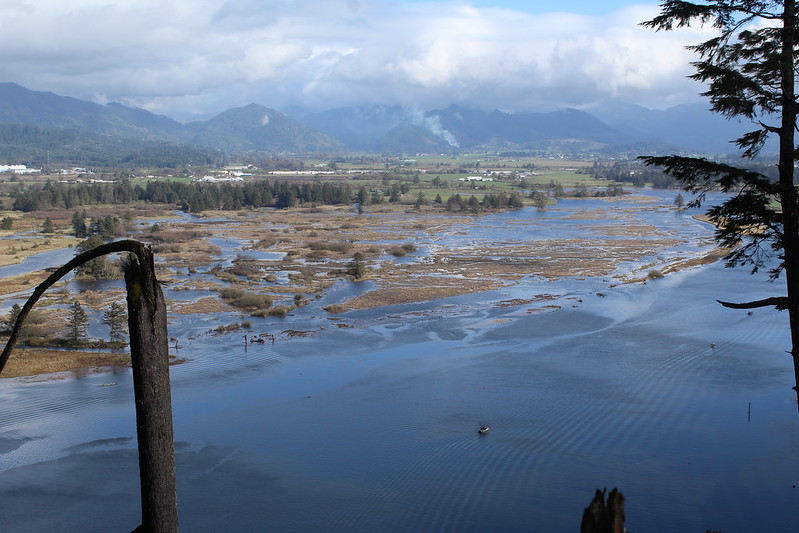
By MICHELLE KLAMPE/OSU News Service
NEWPORT — A 443-acre tidal wetland habitat restoration project in Tillamook Bay designed to reduce flooding and improve salmon habitat also brought a host of other socioeconomic benefits to the community, according to a new report from Oregon State University researchers.
Since the $11.2 million project was completed in 2017, the restoration has led to improved water quality and salmon habitat, helped prevent floods, increased carbon storage, added recreation opportunities, and increased home values, the researchers found.

“This study provides strong evidence that ecosystem restoration is beneficial to communities as well as the environment,” said Steven Dundas, the report’s co-author and an environmental and resource economist in Oregon State University’s coastal marine experiment station in Newport. “The positive impact on housing values near the restored site alone likely justifies the investment in this project.”
The report’s lead author is Graham Shaw, who recently completed his master’s degree in marine resource management at OSU. The Tillamook Estuaries Partnership and the National Oceanic and Atmospheric Administration’s Restoration Center, two of the partners in the restoration project, commissioned the economic impact report.
The primary aim of the wetlands restoration was to reduce severe and disruptive flooding in the city of Tillamook and on U.S. Highway 101 as well as improve habitat for salmon, some species of which are considered threatened or endangered. NOAA and the Federal Emergency Management Agency paid for much of the project.
Understanding project economics
The goal of the new report was to better understand the breadth of economic benefits a tidal restoration project might produce, said Lauren Senkyr, a biologist with the NOAA Restoration Center.
“This kind of information helps us to be able to talk about the community benefits of restoration projects,” Senkyr said. “Projects like this have ripple effects. Not only do they help the fish, they also help people.”
A concurrent NOAA economic impact analysis showed that during the four years the restoration work was underway, the project supported 108 jobs and $14.6 million in total economic output.
Shaw worked with Dundas to identify and quantify additional socioeconomic benefits of the project. They reviewed data from before and after the restoration, made comparisons to spot changes and conducted an analysis of the housing market to identify changes to home values near the restoration area.
Among their findings:
- Homes within three-quarters of a mile of the restoration site increased in value by 10 percent, or an average of $19,000, compared to homes further away. Modeling estimates the total benefit of the project on housing values to be approximately $19.1 million.
- Reductions in flooding on Highway 101 in Tillamook’s business corridor may lead to reductions in costs associated with travel delays of up to $7,200 per flood event.
- The number of juvenile chinook salmon and staghorn sculpin using the affected wetlands has increased since the restoration was completed.
- Sediment from the Wilson and Trask Rivers is likely to be trapped in the restoration area, improving water quality in Tillamook Bay and potentially reducing the frequency or need for dredging. That latter impact could save anywhere from $1,500 to $8,000 per year.
- The restored wetlands may store as much as 27,000 tons of carbon, at a value of up to $736,000 based on current social costs of carbon.
- The publicly accessible restoration site offers increased opportunities for recreation, including walking, fishing, kayaking, birdwatching and educational activities. Activities such as kayaking and wildlife viewing have an estimated value of $60 to as much $471 per person per day.
“The restoration project created a large area for increased recreation that wasn’t there before,” Shaw said. “It wasn’t accessible for people in the community the way it is now.”
Decreasing flood impact
Anecdotally, the project so far is meeting its intended goals of improving salmon habit and reducing flooding risk. Since the restoration project was completed, Tillamook has only experienced two minor, five-year flooding events, and in both cases, the flooding was less severe than previous similar floods.
“In both cases, the amount of flooding was 9 inches less than previous floods. It took two to three hours longer for the city to flood and the floodwaters receded two to three hours sooner than it would have previously,” said Kristi Foster, executive director of the Tillamook Estuary Partnership.
More study is needed to better understand the impacts of the restoration project over time, the researchers said. They also suggest engaging in socioeconomic analysis work early in a project, rather than waiting until the project is complete.
“There were some challenges associated with trying to study the socioeconomic changes after the fact,” Dundas said. “Starting earlier in the process would allow researchers to collect more before-and-after data and better understand people’s perceptions about the value of a project in advance.”


